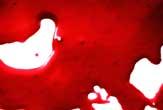New CSI Camera ‘Sees’ Invisible Blood Stains

A heat-vision camera could one day help crime scene investigators photograph hidden bloodstains and other clues, scientists say.
A prototype of such a device could detect blood diluted to as little as one part blood in 100 parts water. In tests, the camera was also capable of making out invisible stains and patterns from backgrounds of four different types of fabric, and could distinguish between blood, household bleach, rust, soda and coffee.
The most popular current method for detecting hidden stains made by blood and other bodily fluids at crime scenes involves a substance known as luminol, which glows, or “fluoresces,” when mixed with the iron found in blood.
However, luminol has certain disadvantages — it is potentially toxic, it has been reported to dilute blood solutions below the limits needed to detect DNA, it can smear blood spatter patterns that could otherwise yield insights on how a crime was committed, and it can provide false positive results.
Infrared eyes
Instead of relying on luminol, chemists at the University of South Carolina funded by the National Institute of Justice have developed a camera that can see otherwise invisible stains without tampering with them.
"This is an approach that can detect substances on a surface without touching the crime scene," said researcher Stephen Morgan, an analytical chemist at the University of South Carolina.
Sign up for the Live Science daily newsletter now
Get the world’s most fascinating discoveries delivered straight to your inbox.
The device captures hundreds of images in just a few seconds while illuminating scenes with pulses of infrared rays. A number of the photos are taken through carefully designed filters that block out specific wavelengths, allowing light from the molecules investigators are looking for to stand out from their surroundings.
Investigators can swap out filters depending on what substance they are looking for. For example, to detect blood, they employ a filter coated with albumin, a protein found in egg whites and blood plasma.
"You can use different filters to look for drugs, fingerprints, explosives, whatever you want," Morgan said. Computer simulations help determine what filter materials and thicknesses can best detect a given substance, he explained.
A proof of concept
The prototype is currently a bench-top system that essentially uses spinning fan blades in front of a hot plate to generate the pulses of infrared radiation. Future devices would presumably rely on more portable emitters of infrared light pulses, such as infrared LEDs, as well as higher-resolution cameras.
"Our study is entirely a proof of concept, and validation studies remain to be completed," Morgan cautioned. "It will take a lot of work to try and miniaturize this before this becomes a commercially available handheld system, but it will be possible."
Morgan, with physical chemist Michael Myrick and graduate students Heather Brooke, Megan Baranowski and Jessica McCutcheon, detailed their findings online Sept. 23 in the journal Analytical Chemistry.











